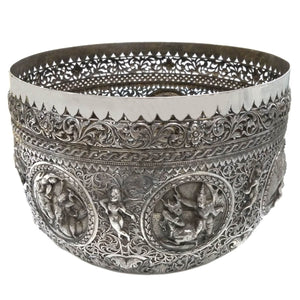Between the 9th and 19th centuries AD, Burmese kings had a retinue of craftsmen and silversmiths who were commissioned to craft silverware for their palaces and royal courts. For thousands of years, Burmese silver objects depicted Buddhist symbols and epic mythological scenes from the Ramayana and the Mahabharata. These sumptuous objects reflected their owner’s wealth and power. Stylistically, Burmese silver often had figures set in high relief, the work was often pierced and the base chased with the maker’s own particular mark or ’signature’. The artists drew their inspiration from nature, adorning their vessels with intricate foliage. Burmese silver from the Raj period (the time of British rule) typically consists of drinking cups, betel and lime boxes and thabeik bowls (begging bowls). European forms, such as tea sets and other household and personal items, are not found as commonly as in Indian silver, but are occasionally seen. Shan Silver from eastern Burma is a different style of Burmese silver. Floral patterns are seen in low relief densely covering the bowl and zodiac signs are displayed at the centre within roundels.
